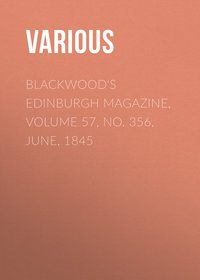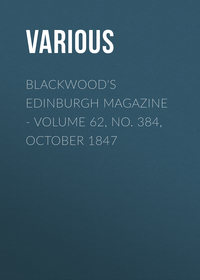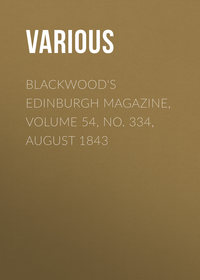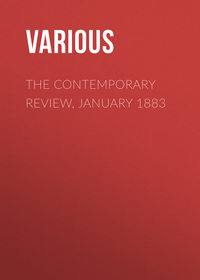 полная версия
полная версияLippincott's Magazine of Popular Literature and Science, Vol. 26, August, 1880
During a thunderstorm in France in July, 1858, a peasant-woman, on her way home from the fields, was struck down by lightning. No wound was detected upon her person, but her hair was singed and a part of a silver comb melted. Here metal seems to have conducted the electricity to the body. On the other hand, the traveller Brydone relates a circumstance which happened to a lady who was regarding a thunderstorm from her window. At a flash of lightning her bonnet was reduced to ashes, nothing else about her being affected. Brydone supposes the electric current to have been attracted by the metallic wire which maintained the shape of her bonnet. Hence he proposes that either these wires be abandoned or in times of danger a metallic chain be attached to the bonnet, by which the charge might pass to the earth. Accordingly, we find that it became fashionable in France at that period to wear on the top of the bonnet an ornament of bright metal connecting with a small silver chain dropping down to the ground. At about the same time umbrellas were carried fitted with wires and chain for a similar purpose.
In July, 1819, lightning fell upon the prison of Biberach in Suabia, and there struck, in a common apartment, among twenty prisoners, one only—a condemned captain of brigands, who was chained about the waist. A similar arrangement of metal proved fatal in another case. On the 9th of October, 1836, on the coast of Italy, a young man was struck by lightning and killed. It was found that he wore a girdle containing gold coins. Undoubtedly, danger or safety depends on properly placing the conducting object. It may convey the current to the vital organs or it may ward off the stroke. Probably any line of metal parallel with the length of the body when upright would be in some degree a protection. The noted Dr. King once saw a military company receive a discharge of electricity from the clouds upon their bayonets, whence their muskets conducted it to the ground without harm or any painful shock. On the other hand, a battalion of French infantry, while marching between Mouzon and Stenay, June 2, 1849, was struck by lightning, and two men killed, while about two hundred were struck to the ground. Blood flowed from their mouths, ears and noses. This effect appears to have been the result of the concussion. Similar results sometimes follow from heavy discharges of artillery.
Uniform testimony goes to show that men in metallic armor have never been fatally injured by lightning. A complete suit of metallic armor embodies the principle of the well-known electrical cage of Faraday. This is simply a basket of wire network with its open side to the ground. If the wire is of proper size and the capacity sufficient, this cage is the most effectual protection possible, unless the walls be of solid iron.
If one places beside him a better direct conductor to the earth than his own body, he will not be fatally injured by the electric current, though, if it pass very near, he may be blinded by the glare or deafened by the noise—effects which are usually temporary. Equal safety for buildings may be similarly secured.
Glass being so well known as an excellent non-conductor, some have been led to suppose it effectual in warding off the disruptive stroke. Hence chambers or cases of glass have actually been made for the use of individuals who were apt to be overcome with terror during the prevalence of a thunderstorm. In this belief, also, the vane of Christ Church in Doncaster, England, was furnished with a glass ball; but the spire was afterward struck, causing great damage. Many also think they may sit beside a closed window in safety, but records of holes being melted in the glass and whole windows crumbled to powder by lightning are too numerous to admit of any reliance upon such a precaution.
In the case of silken garments the evidence met with does not warrant a statement either for or against them; yet there appears to be no reason why this non-conductor should be more of a safeguard than any other. No doubt an abundance of gold and silver lace, or cloth having threads of these metals, might prove a protection. Feather beds, too, have been regarded as places of safety, but persons have been killed by lightning while in bed. Dr. Franklin advised especially that the vicinity of chimneys be avoided, because lightning often enters a room by them. All metallic bodies, mirrors and gilded ornaments, he held, should likewise be shunned. Contact with the walls or the floor or proximity to a chandelier, a projecting gas-pipe, a position between two considerable pieces or surfaces of metals, unless distant, are all hazardous. Draughts of air are also to be avoided. Bell-wires may generally be considered as protective, though too small to be effectual. Perhaps a hammock, in addition to the preceding precautions, will afford as much security as can be derived from insulation. But in a building having continuous iron walls, posts or pillars from top to bottom, or in one which is properly supplied with conductors in other forms, all the foregoing precautions may be neglected without apprehension. Yet, as was suggested early in this article, the great number of buildings damaged by lightning while furnished with rods has caused much distrust of this system of protection.
From the large number of trees receiving the electric current it has come to be thought by many that these may be the best protectors of buildings if properly placed. In a case coming under my observation a tree received (or at least deflected) the current and communicated it to the house. In many instances, however, the building is struck while tall trees near by are untouched.
There is no doubt that lightning generally strikes elevated rather than low objects, and therefore it has been thought that a building surrounded by steeples had nothing to fear. As previously stated, however, the bolt sometimes selects a low object when high ones are at hand. For example, lightning fell upon a house occupied by Lord Tilney in Naples, although it was surrounded on all sides, at the distance of four or five hundred paces, by the towers and domes of a great number of churches, all wet with a heavy rain.
In considering the matter of protection from lightning we must bear in mind that trees, buildings, masts and other elevated points exert no attractive power on the thundercloud except in connection with the great plane where they are situated. The primary cause of the discharge is not in the metals of the building, the exact point or line in which the insulation by the air breaks down being determined by a variety of causes. The elevated points of a building or ship may form a channel for the passage of the current, but it is not the only one nor the cause of the discharge, which would take place sooner or later though the ship or building were absent altogether.
There has been a difference of opinion in regard to the area protected by lightning-conductors, early notions on this point having been much exaggerated. Leroy's, in 1788, is the earliest positive statement which I have met. It is, that a conductor protects a horizontal space around it equal to somewhat more than three times the height of the metal rod above the building to which it is attached. The physical section of the Academy of Sciences of Paris, on being consulted by the Minister of War in 1823, expressed the opinion that a lightning-conductor protects a circular space of which the radius is equal to the height of the rod. Here, apparently, is a wide difference, but possibly the estimates refer to different elevations. Leroy clearly intended an area at a level with the top of the building: thus, supposing the rod to be attached to a chimney six feet in height and to rise a foot and a half above the chimney, then it would protect a radius of about ten feet on the roof. The estimate of the Academy of Sciences speaks of the total height of the rod, and refers to a horizontal area at the base of the measurement, whether this began at the ground or at the top of the structure to which the rod is attached. In this view the estimates do not differ so much as might appear, the latter being about one-third less than that of Leroy. Other French writers estimate the area protected as having a radius of double the height of the rod above the highest point of the connected structure, being twice the radius allowed by the Academy. Later physicists have been cautious in giving figures, for experience has shown that estimates of protection are not accurately observed by the descending bolt. For instance, when Her Majesty's corvette Dido, furnished with the best system of conductors, was struck by lightning, the discharge fell in a double or forked current upon the main royal mast, one of the branches striking the extreme point of the royal yard arm and passing along to the conductor on the mast, while the other fork fell on the vane, spindle and truck; which last was split open. As soon as the discharge reached the conductor all damage ceased.
The practice of the best electricians has now long been to protect all angles and projections, the latter by a branch of the rod, and the former by running a line of rod over them, having at every few feet sharp points of an inch or two in length attached to and standing out at right angles with the rod. Indeed, some go even beyond this, forming points along the whole length of the conductors by notching the corners of a square rod with a chisel. Sometimes a rod is twisted for ornament, but with a loss for practical uses, for in a twisted rod the electrical current is retarded, and a portion of the charge is more liable to leave the conductor.
In England, during our Revolutionary war, an active scientific discussion was carried on as to whether the upper end of a lightning-conductor should be sharp or blunt. "The scientific aspect of the question soon became lost in political acrimony, those who, with Dr. Franklin, advocated sharp conductors, being classed with him and the Revolutionary party, while those who advocated blunt conductors were held to be loyal subjects and good citizens." There is a difference in the action of a sharp conductor and one with a blunt end or terminating in a ball. In the first the point silently receives the current, while in the other the opposite electricities of the rod and cloud may meet with explosion; but the building will not necessarily be injured from this cause. M. Michel proposed to combine the advantages of the two systems by having the rod terminate in a spherical enlargement from which should project points in various directions. This, he thought, would lessen the danger of fusion and control the current at distances where it might escape other forms of terminal. Some American electricians now use a modification of this form, surmounting the rod with a branching tip, while others prefer the single point. The latter is the form used in the American and British navies. The vane, with its appurtenances, is sometimes made the terminal of the conductor, and should at least always be connected.
The practice is also a good one of combining balustrades, finials and other metal-work at the tops of buildings with the system, by which protection is rendered more complete. Especially is it important to connect with a metallic roof at its lower edge, and with the gutters, unless the rain-conductors connect with the earth to its moist mass.
In regard to the material for conductors, copper is undoubtedly the best, but more expensive than iron. The latter is more liable to rust, and on account of its lower conductive power is more easily melted. An electrical explosion which only melts a copper wire would utterly destroy an iron wire of twice the diameter of the former. In being heated a rod contracts in length, and is then liable to fracture by the shrinkage, but if of sufficient size these results are not likely to occur. An iron rod, by successively receiving an electrical discharge, is sometimes reduced in size.
The conducting power of metals likely to be found in buildings is as follows: taking the power of lead as one, that of tin will be two—that is, tin conducts electricity twice as well as lead; iron, nearly two and a half times as well; zinc, four times; and copper, twelve times. From this comparison of conducting power the important fact will appear that when any two of these metals are used in the same line of conduction, the one of low power should be proportionately larger. Sir W.S. Harris—perhaps the best authority on lightning-rods in general—advises that the size of the rod, if of iron, should be three-fourths of an inch in diameter, although he admits that probably never in the experience of man has a rod half an inch in diameter been melted by an electrical discharge. He regarded the extent of surface rather than quantity of metal in the conductor as the measure of its power, while many other electricians hold the contrary opinion.
It is important that the conductor should form an unbroken line throughout its extent, otherwise there is danger that a portion of the charge may be diverted from it. For instance: a large barn struck not long since had a conductor at each of three corners. In order to maintain the uniformity of the four angles of the square hip roof, a rod was run from the main conductor down the fourth angle to the hip, where it terminated in an erect point. A heavy discharge struck the main rod at the cupola, and, descending, divided among the four branches. That on the short branch jumped from its end to the metal sheathing along the angle of the roof, which it followed to the gutter, passing along this to one of the conductors, doing some damage on the way. Had not the charge found a line of metal on which to continue its course from the end of the rod, it would have done greater damage, and most likely have set the building on fire.
Another point of importance is, that the connection of the joints of the rod be perfect, as explosions and fusion occur wherever the surface in contact is less than the size of the rod, unless the latter is much larger than necessary. The hook and the lap joints, if not very carefully made, are liable to this objection. The best connection, no doubt, is that of the screw coupling.
The insulation of the rod from the building is an expense not only without the least advantage, but the contrary. Harris (Thunderstorms, pp. 129, 131) says: "This practice is not only useless, but disadvantageous, and is manifestly inconsistent with the principles on which conductors are applied." Dr. Franklin says: "The rod may be fastened to the wall, chimney, etc. with staples of iron. The lightning will not leave the rod to pass into the wall through these staples. It would rather, if any were in the wall, pass out of it into the rod, to get more readily by that conductor to the earth." The practice may have gained vogue from an observance of the use of glass knobs as insulators of telegraph-wires. Many intelligent people have failed to apprehend the vast difference between the low tension of voltaic electricity and frictional electricity, lightning being in the nature of the latter. The fact that when lightning strikes the telegraph-wire it jumps from the wire to the posts, often tearing in pieces half a dozen in a row, ought to be conclusive in regard to insulating lightning-rods.
The same considerations will also effectually dissipate the fallacy by which the horizontal lightning-rod has duped so many people in certain portions of the West; for if the wire be cut off from the ground-connections (in which condition it accords with the conductor in question) the posts (which answer to the building thus "protected") must suffer still greater damage. So far from being insulated, the rod should be connected with all considerable masses of metal in the building, these having also a good connection with the earth. Frequently during a thunder-shower—sometimes even on the approach of one—all metallic objects will be electrified, and those of considerable size will often yield a spark; and this without the building containing these objects being struck. When struck, the larger masses of metal might occasion a dangerous explosion from induction, though at some distance from the rod: for this reason, as before stated, they should be connected with the ground. Being then liable to receive a part of the current from the conductor in case this be too small, they should be connected with it, as otherwise the current would cause damage in its passage. In a word, therefore, all metal bodies in a building should, as far as possible, be made a part of the system of conduction. This matter is not well understood generally. A dwelling in Boston having been struck by lightning a few years since, a neighbor remarked that "it was fortunate the lightning did not reach the gas-pipe, for it would then have gone all over the house." The fact was, that the bolt did not go more than five feet inside the house before it struck the pipe, and there all damage ended. The idea may be novel to most people, but if the gas-or water-pipes were carried above the roof to the usual height of lightning-rods, they would form a very efficient system of conductors so long as they were connected with the main pipes in the street. Knowing the destructive character of lightning when it passes through air, wood, brick, stone or other non-conductor, people are naturally fearful of allowing the current to run through their houses. But the lion and the lamb are not more different than are the disruptive discharge while passing through a non-conductor and the same current passing through a good conductor.
The system of lightning-conductors in use in the British navy goes through the woodwork of the vessel, the conductors sunk in the side of the masts connecting with the sea through the metal bolts in the hull. After the terrible charge of electricity had fallen on the Chichester, Captain Stewart wrote: "I examined the planks about the bolts, and found all quite fair and water-tight." (These "bolts" formed the lower part of the system of conduction, passing through the bottom of the vessel and connecting with the water.) After twenty-five years' use there had not, as we learn from the British Nautical Magazine for March, 1853, been a solitary instance of serious damage by lightning on ships fitted with these conductors, though many had been struck by heavy discharges. In our own navy the conductors pass from the upper part of the mast over the side of the vessel.
It is not, however, to advocate making the gas-and water-pipes the main lines of conduction that I have made these citations, but to remove in some degree the dread of "having the lightning come into the house." A better conductor would be the metal covering of the roof when such material is used. When a good metallic connection is made between a metal roof and metal rain-conductors, which, in their turn, are well connected with the earth, nothing further is needed for complete protection than a rod soldered to the roof for each chimney or other projection. But as the lightning is liable to melt the plate at the point where it enters, especially if the metal be tin or zinc, it is well to solder points at the angles. Some, "to make assurance doubly sure," carry the rods over the whole distance quite to the ground in addition. All authorities consider such a system as this to be as complete a defence against lightning as possible.
"If," says Harris, "a building or a ship were perfectly metallic in all its parts, no damage could possibly arise to it when struck by lightning, since the explosive action would vanish the instant the electrical agency entered the metal. In applying lightning-conductors, therefore, as a means of guarding against the destructive effects of lightning, our object should be to carry out this principle in all its generality, and bring the building or ship as nearly as possible into that state of passive electrical resistance it would have supposing the whole mass were iron throughout."
After the most careful and extended inquiry possible to him, it is the writer's conclusion that in nearly every case of serious damage by lightning to a building having conductors of any well-known system (except the horizontal, which is not a conductor at all in the usual sense of the word), the failure to protect has been on account of a defective ground-connection. The fact is the more surprising as this connection is so much within control and is the least costly part of the system. This fault has arisen from the failure of lightning-rod men, as well as owners of buildings, to apprehend what constitutes a ground-connection for electricity. If the eye sees the end of the conductor pass a short distance beneath the surface, all the connection necessary is thought to be effected, because "the ground is always wet enough in a shower." In the cities it is customary to connect the rod with the water-or gas-pipes in the street, which makes the conduction perfect. In the absence of these it is best to carry the rod to a well; and it is always desirable to enlarge the lower end of the conductor, which may be done by soldering it there to a sheet of copper. If the termination of the line cannot be carried to a well, it should be deeply buried in a bed of coke or charcoal that has been subjected to a red heat.
A season or two ago a large barn in the vicinity of Boston was struck by lightning, and though there were rods at three of the four corners, three kine were killed by the discharge. The barn stood upon the side of a hill, having a cellar and sub-cellar, the bottom of the last being very moist. An ox stood in one corner, a cow in another and a heifer at a third, and each received a fatal stroke. On examination it was found that the rods entered the ground to the depth of only about one foot, and the soil, being dry, perfectly insulated them. Consequently, on the way to damp earth the currents jumped to the nearest conductors, which happened to be these unfortunate animals. In placing conductors it must not be forgotten that dry earth in general is not a conductor. Neither will any small quantity of surface water serve to check the rage of the electric stroke, unless there is a connection of moisture with the mass of moisture below the soil.
The depth to which lightning may penetrate before it is so dissipated as to lose its dangerous character is shown by the fulgurites, or "lightning-tubes," sometimes found in sandy soils. Their formation has been conclusively traced to disruptive electrical discharges from the clouds, which have melted the sand by the intense heat generated in passing through to a moist earth. These tubes generally divide into prongs, like a parsnip, as they descend. The inner surface is smooth and very bright. It scratches glass and strikes fire as a flint. They are sometimes found three inches in external diameter, and extending to a depth of thirty feet. In one instance five of these tubes were found in a single hill.
This tendency of certain localities to receive the electrical discharge is further illustrated by the number of times certain buildings in every considerable town have been struck. As before stated, the elevation of the structure does not seem to be the determining influence in directing the stroke, for the unfortunate edifice often stands much lower than some others in the vicinity which have always been struck. Numerous illustrations of this can be found in the records of European countries. Hollis Street Church in Boston has been struck several times, though the ground on which it stands is but little above the level of the sea, while the State-House, on the very apex of Beacon Hill, with great quantities of metal in surface and mass, is not known ever to have received a disruptive discharge. It has been supposed that the copper covering of the roof, including the gilded dome, its rain-pipes and four excellent lightning-rods, have had the effect of neutralizing the air about it by constant conduction of mild currents. Yet the rod on the spire of Somerset Street Church, nearby and eastward of the State-House, but lower, has been seen to receive a disruptive discharge. Bunker Hill Monument, about a mile north-west and some twenty feet higher, has several times received powerful discharges, which a good conductor has always carried harmlessly away.
There has also been observed a tendency of the current not only to strike certain buildings, but to enter the earth at a certain point whenever such buildings are struck. Some of our oldest and most successful appliers of rods believe that at certain points there are natural electric currents, or at least readier conduction for them than at others. Yet these points can become known only by repeated disasters. Lightning-rod men who are adepts in their business now take care to overcome adverse currents by enlarging the lower part of the conductors and by carrying them to greater depth.











